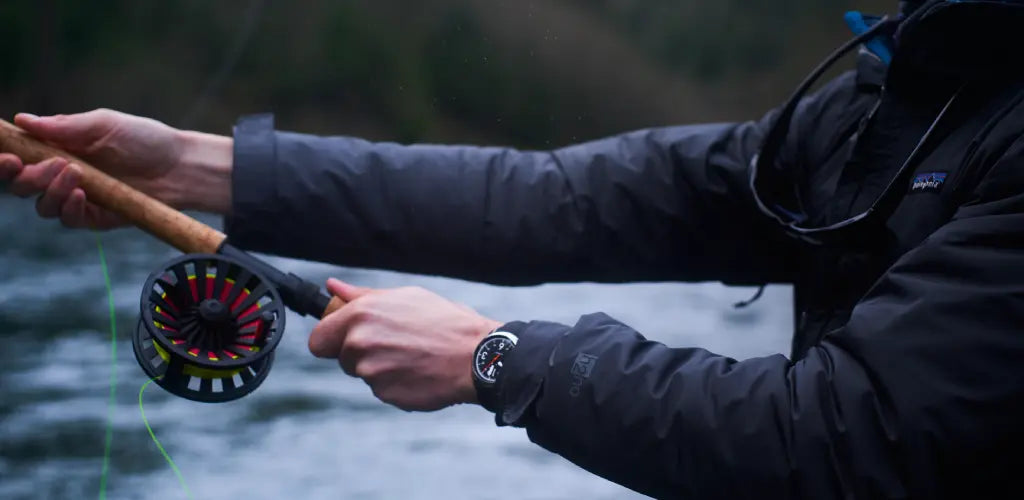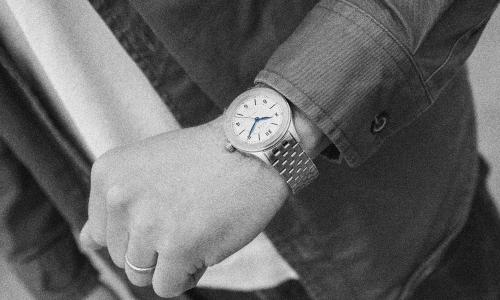How a watch ensures water resistance

With Winter in full swing here in Portland, we are taking every opportunity to put our watches to the test in some Pacific Northwest extremes. Whether it's a quick dunk in a river or the ocean, or long soaks in spas and hot springs, our watches have to stand up to our lifestyle.
We won't be the first one's to say that when the water is roughly 40 degrees, the last thing you're thinking about is your watch's water resistance. But there’s actually a ton of science and engineering that goes into the construction of a watch. Style, functionality, fit, and finish are all considered. But what about something that seems as trivial as a watch crown? None of the details matter if water and debris seep into your watch when you need to rely on it the most.
There are a few things that are done to ensure a watch can sustain 200 meters of water resistance. A watch case thickness (or lack thereof) is a key element in not only water resistance, but fit and function as well. A watch crystal, screw down crown and case back, and strategically placed gaskets all help ensure this water resistance rating.

Crown
The screw-down crown is one of the most important features that gives a watch its water resistance. Dive watches typically have crowns that screw down flush to the case. There is a specially made case tube with threads that secure the crown when you screw it back in after setting the hands. Inside the case tube are silicone gaskets that rest under the crown head to lock out water. More on those later. The same type of mechanics can be found in a watch with a press-in crown, but the change in pressure within the case when going underwater will push air out of the watch, which then lets moisture in.
Case
A dive watch’s case size should be slim enough to fit comfortably under a wetsuit, and be relatively unobtrusive with its external design features. Imagine wanting to check the time elapsed since you’ve been under water, but your watch’s blunt edges make it impossible to slide your wetsuit over to take a look. Sure, your watch may look cool. But feature heavy watches may become your enemy when its supposed to be your trusty sidekick.
Along with being slim and contouring, a watch case needs to have some real reinforcements built in to make sure it can keep out water during active wear. We built stainless steel flanks on the case of the Open Water dive watches to protect the crown from damage and accidental unscrewing. Its a simple feature that adds a huge amount of security and durability to the series.
One of the coolest water protective designs is a “monobloc” watch case. This type of watch doesn’t have a case back. The movement is positioned and installed from the top of the watch (the dial side). This style of case removes the potential of water seeping past the gasket and threads of a case back, and will come with a screw down crown with its own water repelling features. In the case of the original SW and SW-SS, each was built with a monobloc case, aiding in its high 200m water resistance rating.
Crystal
Its important to have a durable crystal on a dive watch. When ascending into deeper waters, a sapphire crystal will stay put, versus a mineral glass crystal that can crack or splinter with enough pressure. In addition to being naturally anti-reflective, Sapphire crystals also have a hardness of 9 out of 10 on the Mohs scale. If you’re unfamiliar, the only mineral harder than sapphire is a diamond, which is a 10 on the Mohs scale.
Gaskets
All VERO watches are designed with a multi gasket stem & crown/case tube configuration. But there is one watch that stands out. The original SW and SW-SS were built with a dynamic piston seal ensuring water resistance, as well as aiding in blocking out dust and small debris. This functionality was inspired by the mechanics of a hydraulic piston, similar to one in a car engine. The case tube has an extended sealing face that remains in contact with the o-ring across the stroke of setting positions, ensuring a sealed watch even when setting the time.
A screw down case back is also a vital feature for a water resistant watch. The watch case will have an indentation where an o-ring, or gasket, rests. When a watch is being assembled, the o-ring will be coated in a thin layer of silicone grease to help create an airtight seal when the case back tightens down sitting flush to the case.

Meter Depths Rating
A dive watch’s depth rating does not automatically mean that it is safe to wear at that depth in a real life situation. For example, a watch with a rating of 30 meters water resistance shouldn’t be worn while diving down 30 meters under water. The watch was tested in a controlled environment with few variables, and few testing sequences with sustained pressure. Here are some rules to gauge actual water resistance:
- Watches with 3 ATM (30 meters/100 feet) are suitable for everyday use. They can handle splashing, but are not suitable for bathing or swimming. A watch with this rating likely has a pressed case back with little or no barrier to keep out water.
- Watches with 5 ATM (50 meters/165 feet) can be worn daily, and can handle bathing, but will likely have issues when fully submerged while swimming for extended periods of time.
- Watches with 10 ATM (100 meters/330 feet) are suitable for swimming, bathing, and even snorkeling, and some diving. But not yet suitable for diving for an extended period of time. The VERO Workhorse has a water resistance rating of 120m, which makes it a great field watch for most activities.
- Watches with 20 ATM (200 meters/660 feet) are perfect for water sport activities, such as scuba or skin diving. These watches typically have screw down crowns and case backs that lock out water and debris. The VERO Open Water series automatics have a water resistance rating of 200m and are built with all the moisture blocking components to ensure water resistance while diving.
- Watches with a range of 20 to 50 ATM (200-500 meters) are suitable when doing high impact water sports, as well as scuba and saturation diving. Saturation diving is an occupation that calls for extended periods of time under water. They can spend weeks under water at great depths.
- Watches with 100 ATM (1000 meters) are recommended for extreme types of diving. This is for those exploring sunken wrecks, high altitude divers, and those doing long duration diving up to 3 hours at a time.
Wet Test VS Dry Test (Air Test)
A dry test, also known as an air test, involves measuring the amount of warping the crystal does while in a vacuum chamber. The wet test is done by pressurizing the chamber before submerging the watch in water, and then depressurizing the chamber to reveal any leaks. Watchmaker’s like to say “if you see bubbles, you know you’re in trouble” (or at least ours does).
The condensation test is an additional test that can be done after the wet test to check for water has made its way into the watch case when it was submerged in the pressurized tank. It involves heating the watch, then you can either put the watch in a cooler or place ice on the crystal to check if condensation starts to build in the watch. These tests are important to ensure that the watch can withstand exposure to water and moisture, plus varying temperatures.

Open Water Automatic
We couldn’t write about diving without talking about the VERO Open Water series automatic watches. The Open Water automatic is a dive watch at its heart. We built this waterproof watch for men that seek to dive deeper and climb higher. Designed and tested to endure whatever you can throw at it, including 200 meters of water resistance. Yes, we know that you can’t actually dive to 200 meters (about the height of the Seattle Space Needle), you’d be crushed by the water pressure. However, the Open Water’s water resistance rating protects it from any diving you may do, no matter how deep you go.






